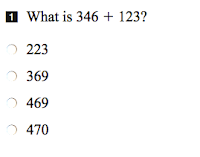Concern 1: Counting versus Measuring
As a province, 81% of the students got this correct. It is a classified as a Knowledge question. Initially, we might be encouraged with this, but I wonder if this is really a test of a student's understanding of measurement: maybe they are getting the correct answer simply by counting. As I have written about previously, there is a misconception that some students hold onto when they believe that a measure is discrete and not continuous. This particular question doesn't actually tell me if students really understand volume.
Concern 2: Teaching Conversions
About 70% of the province's students got this correct.
I worry about questions like this as I do not see this as a practical conversion. Who really needs to know how many millimetres a classroom is? Still, it is a better question than this one from a few year's ago:
I have yet to meet any firefighter that knows the length of their truck's ladder in decametres. Now, part of the problem with these questions stem from the specific expectation in the curriculum:
- select and justify the appropriate metric
unit (i.e., millimetre, centimetre, decimetre, metre, decametre, kilometre) to measure length or distance in a given real-life
situation
I have a problem with decimetres and decametres being included in the curriculum as there are precious few real-life situations that we actually use these. And fire trucks are not one of those. Nor is using millimetres to measure a classroom. A much better question would be to ask a student to measure a line and write the answer in centimetres and millimetres.
So why are decimetres and decametres included? Maybe it is to 'fill in the gaps' in the metric system but then we fall into the trap of using these mnemonics:
I always cry a little bit when I see something like this: try using it to convert 5 square metres into square centimetres and you'll see why. If we teach conversions this way, we end up with worksheets like this:
Asking students to change from cubic hectometres to cubic kilometres will not improve students' measurement sense. It is much better to get students to physically measure objects using tape measures, scales, measuring containers etc. that have the different units on them (e.g. metres, centimetres, and millimetres marked on a metre stick). We should never teach conversions without giving students plenty of practical experience measuring objects. But it would also be better to ask more practical questions like these from earlier EQAO papers:

Concern 3: Developing Formulas
I have written before (here, here, and here) on the importance of developing formulas with our students. Simply giving a student a formula to memorise is not good enough: Students must be given the opportunity to see why a particular formula works. This will necessarily involve a concrete-diagrammatic-symbolic approach (as outlined in this post).
So when half our students answer this correctly:
I wonder how many of them actually learned about surface area by using cardboard cereal boxes and physically running their hands over the 6 rectangles present and seeing that there were in fact three pairs of rectangles: front and back; left and right; top and bottom.
Also, how many of our students also had to work with open-topped (and even open-bottomed!) boxes? For surface area, I wouldn't even give the students the formula SA=2(lw+lh+wh): it is much better to get them to see that the surface area is the sum of all the required faces.
Of all the released questions, this was the one that our students were the least successful in: only 37% got it right.
Why is this? From the responses, we know that the students who chose the second option multiplied the 7 and the 4. Those who chose the triangle simply did 6 times 5. So did these students develop the formula with their teachers or were they just given it? It is too hard to say, but my sense is that those who have developed the formula are more likely to remember it and use it it correctly. But what about those who have developed the formula but in the pressure of the test, forgot it? Grade 6 students are not allowed to have the formulas displayed in the classroom for the test. Grade 9 students, on the other hand, are each provided with an individual formula sheet. I have yet to make sense of EQAO's rationale for this but I wonder how much more successful our students will have been if they developed the formula AND had access to the formula for the test. Also, I wonder if the question is a true reflection of the specific expectation:
develop the formulas for the area of the parallelogram and the area of the triangle, using the area relationships among rectangles, parallelograms and triangles.
For example, the triangle above is not shown related to its generating 6cm by 5cm rectangle.
To end with, it is not just our students who need to see how formulas are developed. At a Math Café for parents earlier this year, I developed the area of a circle with them:
Afterwards, parents told me that they wished that they had been taught this way when they were at school as opposed to being told simply to memorise a set of formulas.


















































